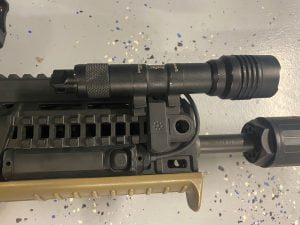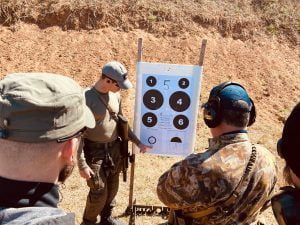The Optimal Set up for the IWI X95 Tavor
The IWI Tavor SAR and the later improved X95 was originally designed as a new modern battle rifle for the Israeli Defense Force in the early 2000s. The rifle was the answer to the constant urban warfare that the IDF was contending with during the Intifada days; A shorter and more maneuverable rifle than the Galil and M16/M4 that was fielded by infantry units at the time but without compromising on barrel length and in turn muzzle velocity. Due to its unique design and shorter overall length the IWI X95 Tavor poses some interesting challenges when it comes to optimal set up and use. In this article I will outline what I believe to be the most optimal set up for the rifle based on both using it in the field as an IDF soldier and running it on a regular basis as an IWI Academy instructor.



Let’s get a grip on this rifle (pun intended). In the US market, the X95 typically ships with a cutlass grip. Personally, I am not a fan of it. I believe that the IDF pistol grip is much more comfortable as my middle finger does not slide behind the trigger. Those that live in colder climates tend to like the cutlass grip better as it gives them more space when wearing gloves. The cutlass can also give people one more point of contact if they bring their support hand’s forearm under it. Most of my students in Texas were very happy once they switched out the grip.
The trigger on the X95 comes in at about 5.5lbs and is similar to a two stage trigger. Although both Timney and Geissele both make aftermarket triggers and trigger packs for the gun, I personally do not really see a reason to upgrade. It’s not a precision gun and even without the specialty trigger I find myself regularly grouping at about 1.5MOA.
The butt stock on the 16.5 inch barrel X95 Tavor in the US is a bit different than the stock flat plastic stock of the IDF issued Tavor (though the SBR X95 does come with the flat stock). The main reason for this is the overall length requirement to ensure it is not an NFA item that requires a $200 tax stamp and registration with Uncle Sam. With that being said, there are some advantages to this; mainly it gives a bit more length of pull which is especially useful when shooting off the weak side as it keeps brass from flying into your face. Additionally, the rubberized stock tends to slip less than the flat plastic stock. A worthwhile upgrade is the Manticore arms curved but plate which really helps keep the stock in the shoulder pocket.
Optic selection is a blog post that could stand on its own! With that being said, there are a few parameters that will help you make a good choice.
- How far will you be shooting?
- Do you have any vision issues like an astigmatism?
- And most importantly what is your budget?
The above will help you make a better decision of what optic to buy and will narrow down between the following; Red dot or holographic sight? LPVO or fixed power optic? Dot with a magnifier? Regardless of the type of optic you choose a lower ⅓ optic height (1.7”) should be the minimum. In fact, the back up sights on the Tavor co-witness with a lower ⅓ height sight. Personally, I really like having a Holographic sight like the Vortex UH-1 gen II on a Unity Tactical riser on my X95. My reticle is visible no matter what the conditions are (rain, mud, snow, etc) and the riser helps keep my head upright and comfortable.
Due to the very short and limited rail space on the X95 Tavor, mounting a light that is easy to manipulate can be tricky. I’ve found that a Surefire Scout or Streamlight Protac light with an Arisaka offset picatinny mount works perfectly and actually allows for a pressure pad to perfectly fit between the rail, bottom hand guard and the offset mount. Another great light solution is the Streamlight TLR RM2 or a Surefire that has a dual endcap – this essentially gives the option for both a pressure pad and button on the light. Whatever light you choose, make sure it is easily accessible without having to change your grip and can be accessed when your shoot off your weak side.

As the Tavor has 360 degrees of rail coverage some prefer a fore grip. Personally, I am not a fan. However, people with very long arms tend to find it more comfortable to have a fore grip or an angle grip as it puts their wrist in a much more comfortable position.
Civilized people shoot their rifles suppressed. Due to the over gassed nature of the X95 there are only two brands of suppressors that I recommend because of their unique design that reduces blow back. The OSS HX-QD line (now HUXWERX) or the CGS Hyperion/Helios models. Personally, I run the OSS HX-QD Ti 5.56 suppressor on my X95 but the 7.62 also works exceptionally well. The main benefit of the OSS is that it is quiet at the ear and extremely easy to mount and dismount on the gun due to their reverse threaded muzzle devices. The CGS suppressors offer even more sound and blow back reduction but are significantly more expensive than the OSS suppressors and do not offer a good mounting system.
Every rifle must have a sling just like every handgun must have a holster. I am a huge fan of the Savvy Sniper dual point sling. The sling gives easy adjustability through its adjuster loop as well as flexibility due to its partial elastic nature. I always recommend mounting the front QD point just behind the grip and the back end on the opposite side of the butt stock. This allows for maximum maneuverability and comfort when manipulating the gun, transitioning shoulders, and transitioning to a secondary weapon. The front attachment point can always be moved to the front most QD socket for more stability.
A rifle must be set up to facilitate shooting and manipulation. The IWI X95 Tavor poses unique but manageable issues when it comes to set up. A simple understanding of set up when it comes to grip, optics, slings, and suppressors can make shooting your Tavor much easier and more enjoyable uses when it comes to set up. A simple understanding of set up when it comes to grip, optics, slings, and suppressors can make shooting your Tavor much easier and more enjoyable.

Happy shooting!
